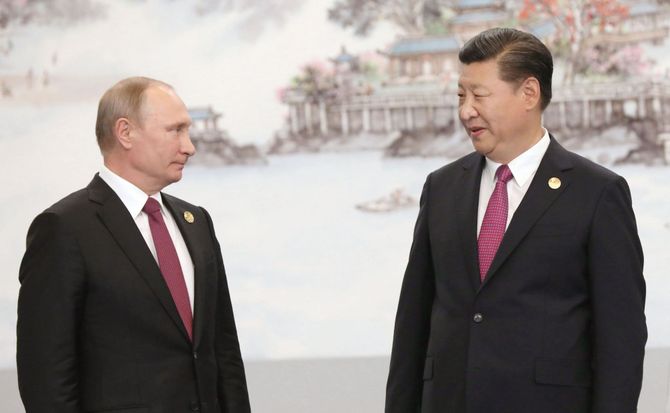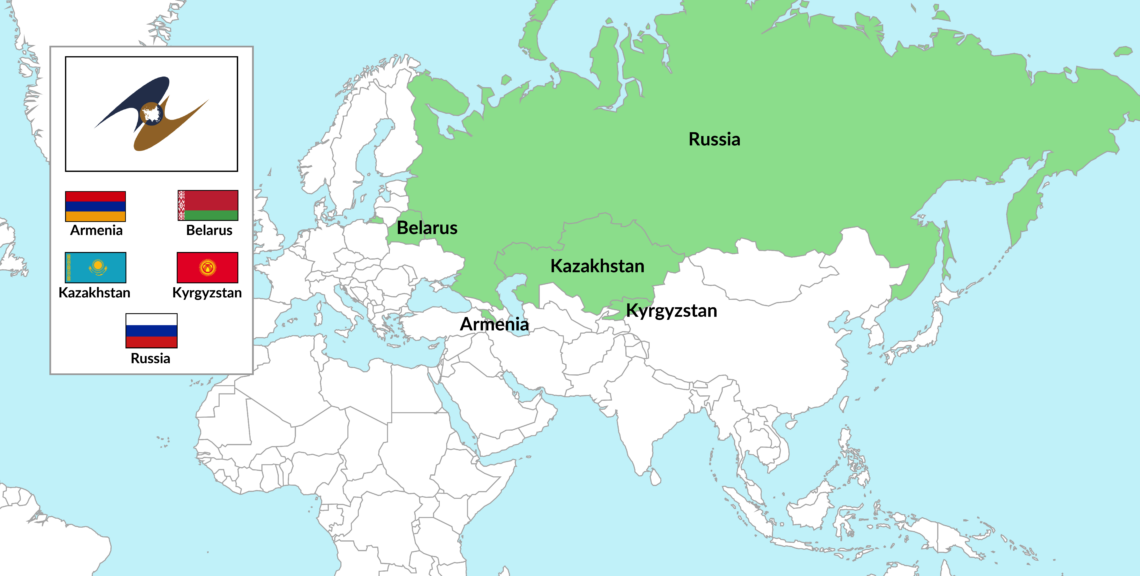Greater Eurasia – a Kremlin pipe dream
The Kremlin’s vision for a “Greater Eurasia” partnership with China is often held up as Russia’s most important geostrategic priority. According to this concept, the two countries would control a powerful bloc of non-Western states to challenge American hegemony.

In a nutshell
- Russia’s “Greater Eurasia” strategy is intended to return it to great power status
- It depends on cooperation with China in the region on equal footing
- Russia is much more likely to end up in irrelevance than in a partnership
The deepening rift between Russia and the West has given new urgency to the Kremlin’s “pivot to the east.” It holds up its vision of a “Greater Eurasia” as the country’s most important geostrategic priority. A pet project of President Vladimir Putin, it figures prominently at high-level meetings with international experts, like at the recent Valdai Discussion Club in April.
The ambition is for Russia and China to form and control a powerful bloc of non-Western countries that can challenge American hegemony. Advocates of this plan exude a great deal of confidence, and at a casual glance, they do seem to have reason to celebrate.
The past decade has seen a steady stream of good news about Russia and China coming closer together. Trade is rising, military cooperation is deepening and meetings at the highest levels confirm that the relationship is growing stronger.
But a closer look reveals that for all the short-term bravado, the two sides have very different long-term objectives. Beijing will not offer any favors out of kindness and China’s brute economic force will end up overwhelming the Kremlin’s political posturing. Russia will be increasingly marginalized.
What started as a heady vision of enhancing Russia’s role in the region has become a last stand of its dream of returning to great power status.
What started as a heady vision of enhancing Russia’s role in the region has become a last stand of its dream of returning to great power status. As Moscow clings to the pipe dream of joint Sino-Russian rule over “Greater Eurasia,” Beijing goes about conducting its own business. In China’s own plans, Russia features peripherally at most.
Looking to the east
Russia’s pivot to the east was a key theme while it hosted the 2012 meeting of the Asia-Pacific Economic Cooperation (APEC). Newly elected to a third term as president, Mr. Putin symbolically opted to host the meeting in Vladivostok, a city whose name literally means “lord of the east.”
In his speech, Mr. Putin spoke of opening a window on the Pacific, recalling for all educated Russians and foreign observers, Tsar Peter the Great’s proclamation that his new capital St. Petersburg was opening a window on Europe. After long neglecting its own Far East and following a sharp decline of its relevance as a regional player, Russia signaled that it was ready to resume the role once played by the Soviet Union.
The APEC Summit was preceded by a huge infrastructure investment program, the designation of Vladivostok as a free port and the formation of the Far East Development Department and a Far East Development Company. Since 2015, Vladivostok has also played host to the annual Eastern Economic Forum. All of this has been in the hopes of attracting substantial foreign investment. As President Putin put it, the expectation was Russia would “catch the Chinese wind in our economic sail.”
The peak of optimism came in May 2015. At a meeting in Moscow, it was announced that development of the newly-formed, Russia-led Eurasian Economic Union (EAEU) would be aligned with the emerging Chinese mega-project, the Belt and Road Initiative (BRI). Announced by Chinese President Xi Jinping in 2013, the project is backed by a huge investment program and aims to fundamentally transform the transport infrastructure of Eurasia.
Facts & figures
Eurasian Economic Union

Russia was clearly hoping that much of this investment would upgrade its own dilapidated infrastructure, and that the economic upswing would increase its political influence. In 2016, Mr. Putin rolled out his vision of “a great Eurasian partnership.”
By then, however, the game plan had changed. Even before the crisis in Ukraine, it was clear that the Russian vision of joining all former Soviet Republics into the EAEU to rival the European Union would fall short. Then, the Ukraine crisis brought not only estrangement from the West but also growing reluctance from other states in the region to join with Russia.
Increasingly convinced that the prospects for restoring cooperation with the West have become unlikely, Moscow is left with little choice. Turning to the east no longer sends a defiant signal to the West that Russia has other options. Instead, it has the air of a last-ditch effort in a struggle to maintain an image of being a regional leader in Eurasia.
Signs of progress
On the surface, it may appear that things are going well. Trade is expanding, and a series of very large deals have been made for Russian energy and advanced weaponry. Joint naval exercises have been held, featuring Russian vessels in the South China Sea and Chinese vessels in the Baltic Sea.
Perhaps the most important sign of how the two sides are coming together lies in a deepening cooperation in space. It has been rumored that during recent joint naval exercises, the Russian navy provided the Chinese with an uplink to Russian satellite intelligence, helping them track American naval assets.
Russia and China have a common interest in creating a rival institutional order for the global economy.
Plans are also under way for a merger between the Russian Glonass and the Chinese BeiDou satellite navigation systems, which would certainly give American naval planners cause for concern. Yet the most these moves may offer Russia is an opportunity to thumb its nose at the United States.
That does not mean that one should discount the steady stream of mutual Sino-Russian praise as empty noise. For the moment, both sides have obvious reasons to cooperate. Beyond taking a joint stand against American hegemony and outside interference in their internal affairs, there is a common interest in moving toward the creation of a rival institutional order for the global economy.
That vision is aimed at reducing the powerful role of the dollar, and of “Western” institutions like the International Monetary Fund and the World Bank. It ranges from the introduction of an Asian Infrastructure Investment Bank to moves toward trade in national currencies, the creation of non-Western rating agencies, and the formation of a clearing system to rival SWIFT.
Unequal partners
While all of these developments present a potent challenge to the U.S., it is far from obvious that there is much for Russia to gain beyond spiting the Americans. What the Kremlin touts as a “strategic partnership” is neither strategic nor a real partnership from Beijing’s point of view. It remains what the British China scholar Bobo Lo branded in a 2008 book an “Axis of Convenience.”
A closer look at how the Sino-Russian “axis” has evolved shows that Russia is much more likely to end up in irrelevance rather than in a partnership, even in a junior role. The experience of the Shanghai Cooperation Organisation (SCO) is a prime example of why.
When the SCO was founded in 2001, its purpose was to mitigate differences of interest between the two great powers in Central Asia. The initial Russian ambition was to form an “energy club” that would allow it to wield considerable influence. In contrast, China wanted it to evolve into a free trade area, in which Russia would have little to contribute.
As it became obvious that China was winning the “great game” over energy in Central Asia, despite initial Russian control over the pipeline grids, the Kremlin’s focus became more closely aimed at providing security. Russian sources enjoy talking about a division of labor, under which China provides economics and investment while Russia contributes politics and security.
As Russia has been forced to accept major losses of influence over trade and energy development in what it has long viewed as its backyard in Central Asia, it has sought to dilute Chinese political influence. It was viewed as a great step forward when in June 2017 Beijing finally agreed to allow India and Pakistan full membership in the SCO.
What the Kremlin will realize soon enough is that the two sides are simply not playing the same game.
The organization represents a bloc of countries with a combined population of around three billion people. Seeking to further enhance its own role as a “balancer,” the Kremlin is pushing hard for Iran to be admitted. That ambition is now more likely following the U.S. withdrawal from the nuclear deal with Tehran.
Although the expansion of the SCO does represent a challenge to the U.S., Russia’s own weight is reflected in its share of the three billion population number –less than five percent. Outside the military sphere, it hardly features in discussions of Chinese and Indian technology development.
What the Kremlin will come to realize soon enough is that China has moved beyond the SCO and that the two sides are simply not playing the same game. The reason is that the BRI has gained such momentum that it is rapidly becoming the only show in town. It involves 60 countries and hundreds of billions of dollars in investment, and it has only peripheral interest in Russia. Beijing hardly ever mentions the EAEU, preferring to deal with its members on a bilateral basis.
Different goals
By far the most important feature of the Sino-Russian partnership lies in the fundamental contrast between how the two sides view its purpose. To the Kremlin, it is about clinging to a failing dream about a return to great power status. To Beijing, the purpose is threefold: to provide security to the north, to help balance the West, and to ensure a steady flow of resources into its own economy. All three have been successful.
After the global financial crisis, China profited from a Russian fire sale that involved good deals on oil and unprecedented access to high-tech weaponry, such as the S-400 air defense system and the SU-35 fighter jet. Despite much talk of further deals on gas, the reality is that China is lukewarm about helping to build pipelines. The proposed Altai pipeline is not going to happen, while the Power of Siberia project is moving at a snail’s pace.
The same holds for associated infrastructure development. Despite the BRI, Chinese investment in Russia remains paltry. In 2016, Chinese companies invested a whopping $225 billion abroad. Of this, only two percent went to Russia. Beijing also charges hefty interest on financing for pipeline construction, citing “political-economic risk.”
The pairing of BRI with the EAEU, finally, offers the Middle Kingdom one highly tangible advantage. On their long journey to markets in Europe, Chinese trains now must cross only two borders– one to get into the Eurasian Economic Space and another to cross into Europe. If the price for this substantial reduction in transaction costs is to allow Russian grandstanding about joint leadership, then so be it.
In Beijing, economic action speaks louder than words. As Raffaello Pantucci, director of international security studies at the Royal United Services Institute in London, has put it: “I think from a Chinese perspective, it’s a no-cost thing to let the Russians do this posturing and show off, because [China] will still do the deals they want, and ultimately Russia is in a disadvantageous position.”
When Mr. Putin launched his pivot to the East, his hopes for a genuine partnership with the U.S. had been dashed. Balking at the idea of playing second fiddle to the Americans, he instead decided to throw himself into the arms of the Chinese. As the BRI juggernaut evolves, he should recall the classic metaphor: out of the frying pan, into the fire.







